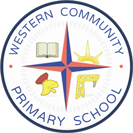When your child is learning to read there are two crucial things to learn:
When your child is learning to read there are two crucial things to learn:
- the sounds represented by written letters
- how to blend the sounds together to make words.
Synthetic Phonics is a way of teaching reading. At Western, we use the highly acclaimed “Read Write Inc” phonics programme. 7 out of 12 schools in the HMI Ofsted report “Reading by six; How the best schools do it,” use Read Write Inc phonics.
Children are taught to read letters or groups of letters by saying the sound(s) they represent – so, they are taught that the letter l sounds like llllll when we say it. Children can then start to read words by blending or synthesising the sounds together to make a word.
At school, you may hear staff talking about blending, but you might also hear them refer to Fred Talk too. All these terms focus on the same point – synthesising sounds.
Each year, in the Autumn term, we have a session for parents to share strategies from Read Write Inc that you can use at home. You can access the Read Write Inc website by clicking the link below.
Saying sounds correctly
This is really important when you are helping your child to learn the sounds. Just remember not to add an uh to the end of the consonant sounds – so saymmm not muh, lll not luh, etc. because then later it’s easier to blend the sounds together to make words.
If you’re not sure then use the sound chart to help
Linking sounds to letters
Encourage your child to make a link between the sound and the written letter shape. Start with the sounds in your child’s name and then look out for them in signs. The sound m in McDonalds is always a good starting point too!
Sounds represented by more than one letter
Some sounds are represented by more than one letter such as sh in ship, ch in chat, th in thin, qu in quick and ng in sing. When you’re out and about point out examples of these to your child too. You might see them in posters, signs, or leaflets.
Practise, practise, practise
Build up a knowledge of the letters and sounds quite quickly with your child and keep practising so that it becomes automatic. Keep reminding ‘Do you remember when we were talking about the sound ch…?’, or ‘Oh look! There’s a big t (sound) on that poster!”
Putting sounds together to read simple words
Say the sounds c-a-t to read cat, sh-o-p to read shop and s-t-r-ee-t to read street. If your child gets stuck and is struggling to blend the sounds, say the sounds yourself, quickly, until your child can hear the word!
Only beginner readers need to sound out every word as they read all the time. But, they will still need to work out new and long words.
Tricky words
Some everyday words in English have tricky spellings and can’t be read by blending. Imagine trying to read the word said or does by blending each letter! These are sometimes called high frequency tricky words or red words. These words just have to be learned by sight and flashcard-type games are a good way to practise these. Stick them up around the house and make a game of it.
Reading books
After your child has read a page, you can read it aloud again, to make sure that the story is enjoyed and understood.
Using pictures
Pictures are great for sharing and talking about a story (which is really important too!) but don’t encourage your child to use pictures to guess the words that they don’t already know.
Writing letters
Teach your child how to write the letters as the letter sounds are learned. And don’t forget to show your child how to hold the pencil correctly too!
Common sense …
Lots and lots of books! Carry on sharing and reading lots and lots of stories and information books to and with your child.
Praise and cuddles! Most importantly, remember that your child will learn much faster with encouragement, praise and hugs
